The beautiful color of a gemstone is its most defining characteristic, and many jewelers consider it to be the most important evaluation criterion.
Color is divided into three basic properties: Hue, Tone, and Saturation.
1: Hue
Hue is the first impression we get when seeing color, but then in it’s purest opaque form.
There are over 16 million hues; the human eye, however, is not capable of distinguishing them all.
In the trade, we normally use 31 hues based on the RGB model (red-green-blue).
All the hues get their own color-code, as the B for blue.
Below are the different hues with their codes.
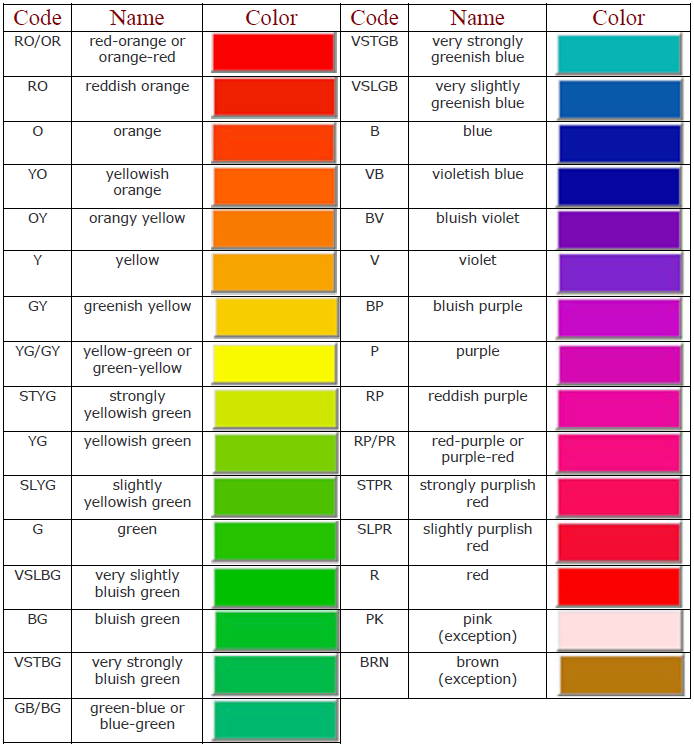
Below are three green gems, showing a variation in hue position:
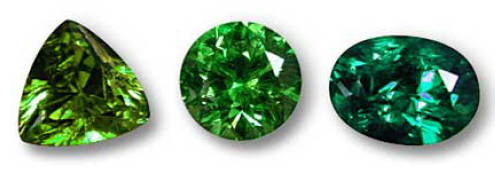
The round center stone is a straight green, while the trillion-cut stone at left is a more yellowish-green and the oval stone at right a slightly bluish-green.
Generally speaking, a hue position is of less importance than saturation.
2: Tone
Tone (or value) is lightness or darkness in color.
There are 11 stages of tone, ranging from 0 (for colorless) through 10 (for black).
Professionals in the trade use only 7 of them (from 2 through 8).
Tones are described by which place they hold on the tone-scale.
In general, a “5” (Medium) or a “6” (Medium Dark) would be idealб but as color perception is somewhat subjective; this is debatable.
Below is the tone scale.

This picture on the right illustrates tone variations best.
As you can see at the top, the hue looks almost white.
Then it goes from a very light to a pure blue and ends in a very dark-toned blue.
A perfectly balanced tone of blue would be somewhere just below the middle.

3: Saturation
Saturation (or chroma) is the purity or intensity of the hue.
We can graduate saturation on a scale that goes from 1 to 6.
The lowest grade means that the hue looks grayish (for cold colors like green and blue) or brownish for the warmer colors (like red, orange, and yellow).
The highest grade (6) is used for hues that are pure in their hue.
We call that “vivid.”
From grade 4 onwards, there should be no gray/brown in the hue.
Below are the descriptions and a saturation scale. Saturation:
1. Grayish (Brownish)
2. Slightly Grayish (Brownish)
3. Very Slightly Grayish (Brownish)
4. Moderately Strong
5. Strong
6. Vivid

Now that we’ve got a way to communicate what a given color is, a method is needed to suggest which ones are better than others.
It’s no longer as simple as a linear scale-like diamond grading uses.
The result is not absolute, and therefor can easily be debatable: this, just on itself, mirrors very well the somewhat opaque nature of the colored gemstones trade.
In Blue Sapphires, for example, these are considered the most beautiful, sought after and expensive colors, with the best being, as we said previously, a balanced tone value of 5 or 6 and a Vivid grade in saturation (Vivid Medium):

Here you see the relationship between tone and saturation in a blue hue.
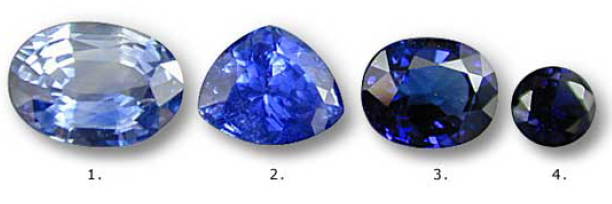
In the above picture, four blue sapphires are showing a variation in saturation and tone.
Stone 1 possesses a light tone and low saturation.
Stone 2 is close to ideal in both tone and saturation.
Stone 3 has greater saturation than Stone 2 in some areas, but its overall tone is too dark, and it shows too much extinction.
Stone 4 is so dark in a tone that its saturation is reduced.
The first difference between colored stones and diamonds is that clarity has different meanings for different types of stones.
Thus in an emerald, a stone that appears to the naked eye to be reasonably clear with only a few minor inclusions visible to the eye is considered a pretty good emerald, clarity wise, yet if it’s an aquamarine, those same inclusions probably make it a not very desirable stone, as aqua is usually desired entirely free of inclusions to the eye, and even under 10x.
The 2 GIA charts hereunder classifies this very well:
GIA Clarity Grades Chart
Grades | Type I | Type II | Type III |
VVS | Very Very Slightly Included – Minute to not detectable | Very Very Slightly Included – Minor inclusions | Very Very Slightly Included – Noticeable to obvious |
VS | Very Slightly Included – minor | Very Slightly Included – Noticeable to Obvious | Very Slightly Included – Noticeable to obvious |
SI1 | Slightly Included – Noticeable to obvious | Slightly Included – Noticeable to obvious | Slightly Included – Obvious to prominent |
SI2 | Slightly Included 2 – Obvious to noticeable | Slightly Included 2 – Obvious to prominent | Slightly Included 2 – Obvious to prominent |
I1 | Included 1 – Prominent – moderate effect on appearance or durability | Included 1 – Prominent | Included 1 – Prominent |
I2 | Included 2 – Prominent | Included 2 – Prominent | Included 2 – Prominent |
I3 | Included 3 – Prominent | Included 3 – Prominent | Included 3 – Prominent |
Dcl | ——— | ——— | Not transparent |
| Type 1 Gemstones are gemstones thatare normally found to be clean. | Type 2 Colored Gemstones by theirnature have natural inclusions. | Type 3 Colored Gemstones by theirnature have many natural inclusions. (Heavily Included is the norm) |
GIA Gemstone Clarity Types
Type I | Type II | Type III |
Aquamarine | Andalusite | Emerald, Red Beryl, |
There is no flawless or IF grade in this classification system, as no colored stone could attain and maintain in wear the standards for that term that are so well defined in diamonds.
There are seven clarity grades.
The highest is VVS, then VS.
These two are not subdivided as in diamonds.
The SI grade is divided into SI1 and SI2, and the I grade is divided into I1, I2, and I3.
Notice the difference in definition of each grade for each gemstone type.
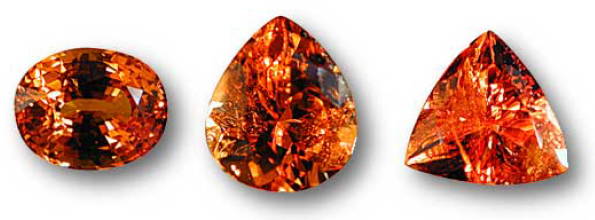
Different levels of clarity are visible here in these spessartite garnets from Nigeria.
The oval stone at left is eye clean, which means no clarity defects visible to the unaided eye.
In the pear-shaped middle stone, obvious clarity defects are visible, while in the trillion-shaped stone at right, they are even more obvious.
Cutting style
The cutting style (facet pattern) is also a somewhat subjective choice.
Because of market demand, manufacturing speed, and cutting yields, certain styles are typically preferred over others.
The mixed cut (brilliant crown/step pavilion) is the market standard for ruby and sapphire, while the step (emerald) cut is the standard for emerald.
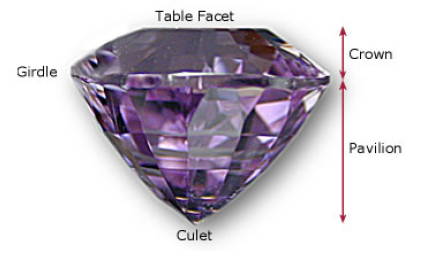
Proportions
The faceted cut is designed to create maximum brilliance and scintillation in the most symmetrically pleasing manner.
Faceted gems feature two parts, crown, and pavilion.
The crown’s job is to catch the light and create scintillation (and dispersion, in the case of a diamond), while the pavilion is responsible for both brilliance and scintillation.
Generally, when the crown height is too low, the gem lacks sparkle.
Shallow pavilions create windows, while overly deep pavilions create extinction.
Again, proportions often are dictated by the shape of the rough material.
Thus to conserve weight, Sri Lankan material (which typically occurs in spindle-shaped hexagonal bipyramids) is generally cut with overly deep pavilions.
In contrast, Thai/Cambodian rubies (which occur as thin, tabular crystals) are often far too shallow.
Symmetry
Like any finely-crafted product, well-cut gems display obvious attention to detail.
A failure to take proper care can be obvious in several ways, including the following:
-Asymmetrical girdle outline
-Off-center culet or keel line
-Off-center table facet
-Overly narrow/wide shoulders (pears and heart shapes)
-Overly narrow/deep cleft (heart shapes)
-Overly thick/thin girdle
-Poor crown/pavilion alignment
-Table not parallel to the girdle plane
-Wavy girdle

Finish
Lack of care in the finishing department is less of a problem than the major symmetry defects above because it can usually be corrected by simple re-polishing.
Finish defects include:
-Facets do not meet at a point
-Misshapen facets
-Rounded facet junctions
-Poor polish (obvious polishing marks or scratches)
Scintillation (‘sparkle’)
This is an important factor in faceted stones.
A gem cut with a smooth, cone-shaped pavilion could display full brilliance but would lack scintillation.
Thus the use of small facets to create sparkle as the gem, light, or eye is moved. In general, large gems require more facets; small gems should have less, for tiny reflections cannot be individually distinguished by the eye (resulting in a blurred appearance).
Dispersion (‘fire’)
This involves splitting white light into its spectral colors as it passes through non-parallel surfaces (such as a prism).
While diamonds show this property to great effect, with most colored stones, their dispersion is too low, and the masking effect of the rich body color so high, that it is not generally a factor.
Exceptions are gems such as demantoid garnet and sphene, also known as titanite.
In gems such as these, a weaker body color can be desirable, making the fire more visible.
Summing up cut
One final note about the cut: the most expensive colored gems often feature misshapen proportions and symmetry.
This is because the value of the material is so high that the cutter strives to save every point in weight, as well as trying to keep the saturation as high as possible, as the more material is taken off, the less saturation will be… as well as the price.
With gems, we are not dealing with opaque, matt-finish objects of uniform color.
Thus it is not enough to describe hue position, saturation, and darkness.
We must also describe the color coverage, scintillation, and dispersion.
Differences in proportions, inclusions, transparency, fluorescence, cutting (windowing and extinction), zoning and pleochroism, can produce vast differences in the color coverage of a gem, particularly faceted stones.
A gem with a high degree of color coverage is one in which color of high saturation is seen across a large portion of its face in normal viewing positions.
Tiny light-scattering inclusions, such as rutile silk, can actually improve coverage and, thus, appear by scattering light into areas it would not otherwise strike.
The end effect is to give the gem a soft, velvety appearance (Kashmir sapphires are famous for this).
Red fluorescence in ruby boosts this still further.
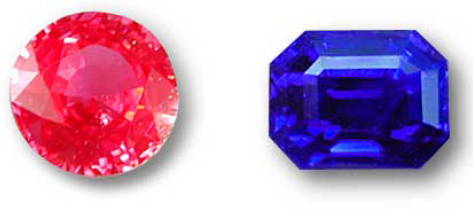
Color coverage can be influenced by a variety of factors, including proportions, fluorescence, and inclusions.
The round Burmese red spinel on the left is strongly fluorescent, and the red emission adds extra power to the red body color, covering up extinction.
With the fine emerald-cut Kashmir sapphire pictured at right, color coverage is improved by tiny needle-like inclusions, which scatter light across the stone, thus reducing extinction.
This is what gives Kashmir sapphires their incomparable velvety color.
Note that both of these gems have highly saturated colors, making them highly desirable.
Windowing is when light passes straight through the center, rather than being reflected.
It is easy to spot; the center will be much lighter than the outside of the gem and have no flashes of light.
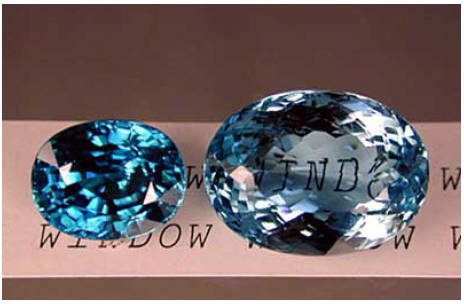
If a gem is cut too shallow, the light will pass straight through, rather than returning to the eye as brilliance.
This is termed a “window” (right).
In well-cut gems, most light returns as brilliance (left).
Brilliant areas are those showing bright reflections.
Extinction is used to describe dark areas where little or no light returns to the eye.
In summary, a top-quality gem would display the hue of maximum saturation across a large percentage of its surface in all viewing positions.
The closer a gem approaches this ideal, the better its color coverage.
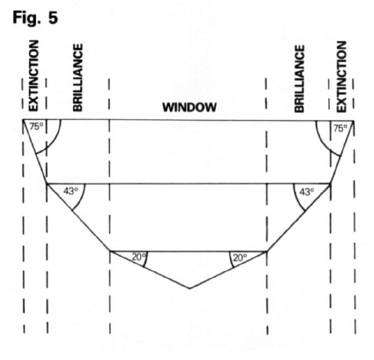
Color zoning can also reduce color coverage. Ideally, no zoning or unevenness should be present.
Color zoning might be described as the uneven distribution of coloring (agents) in a gemstone.
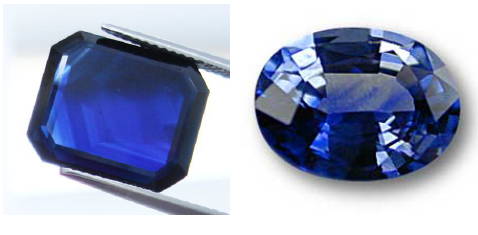
The oval sapphire above shows moderate color zoning.
Moderate to severe color zoning does impact quality, and thus price.
Color zoning is always judged in the face-up position, in a 180° arc from girdle to girdle, with the gem rotated through 360°.
Color irregularities visible only through the pavilion generally do not impact value.
Pleochroism is noticeable face-up in some gems, such as some tourmalines and iolite.
It typically appears as two areas of lower intensity and/or slightly different hue on opposite sides of the stone.

The effects of pleochroism can clearly be seen in this oval green tourmaline.
A bluish-green color is seen along the vertical axis, while along the horizontal axis, the color is yellowish-green.
This is a product of the doubly refractive nature of tourmaline.